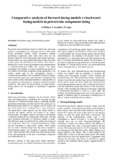JavaScript is disabled for your browser. Some features of this site may not work without it.
| dc.contributor.author | Mohan, Ganesh | |
| dc.contributor.author | Assadian, Francis | |
| dc.contributor.author | Longo, Stefano | |
| dc.date.accessioned | 2016-10-27T14:15:10Z | |
| dc.date.available | 2016-10-27T14:15:10Z | |
| dc.date.issued | 2013-11-11 | |
| dc.identifier.citation | Mohan, G., Assadian, F., Longo, S. (2013) Comparative analysis of forward-facing models vs backward-facing models in powertrain component sizing, Proceedings of the IET 4th Hybrid and Electric Vehicles Conference 2013 (HEVC13), 6-8 November 2013, London, UK. | en_UK |
| dc.identifier.uri | http://dx.doi.org/10.1049/cp.2013.1920 | |
| dc.identifier.uri | https://dspace.lib.cranfield.ac.uk/handle/1826/10890 | |
| dc.description.abstract | Powertrain size optimisation based on vehicle class and usage profile is advantageous for reducing emissions. Backward-facing powertrain models, which incorporate scalable powertrain components, have often been used for this purpose. However, due to their quasi-static nature, backward-facing models give very limited information about the limits of the system and drivability of the vehicle. This makes it difficult for control system development and implementation in hardware-in-the-loop (HIL) test systems. This paper investigates the viability of using forward-facing models in the context of powertrain component sizing optimisation. The vehicle model used in this investigation features a conventional powertrain with an internal combustion engine, clutch, manual transmission, and final drive. Simulations that were carried out have indicated that there is minimal effect on the optimal cost with regards to variations in the driver model sensitivity. This opens up the possibility of using forward-facing models for the purpose of powertrain component sizing. | en_UK |
| dc.language.iso | en | en_UK |
| dc.publisher | Institution of Engineering and Technology | en_UK |
| dc.rights | Attribution-Non-Commercial 3.0 Unported (CC BY-NC 3.0) You are free to: Share — copy and redistribute the material in any medium or format, Adapt — remix, transform, and build upon the material. The licensor cannot revoke these freedoms as long as you follow the license terms. Under the following terms: Attribution — You must give appropriate credit, provide a link to the license, and indicate if changes were made. You may do so in any reasonable manner, but not in any way that suggests the licensor endorses you or your use. Information: Non-Commercial — You may not use the material for commercial purposes. No additional restrictions — You may not apply legal terms or technological measures that legally restrict others from doing anything the license permits. | en_UK |
| dc.title | Comparative analysis of forward-facing models vs backward-facing models in powertrain component sizing | en_UK |
| dc.type | Conference paper | en_UK |
Files in this item
This item appears in the following Collection(s)
-
Staff publications (SATM) [4367]
